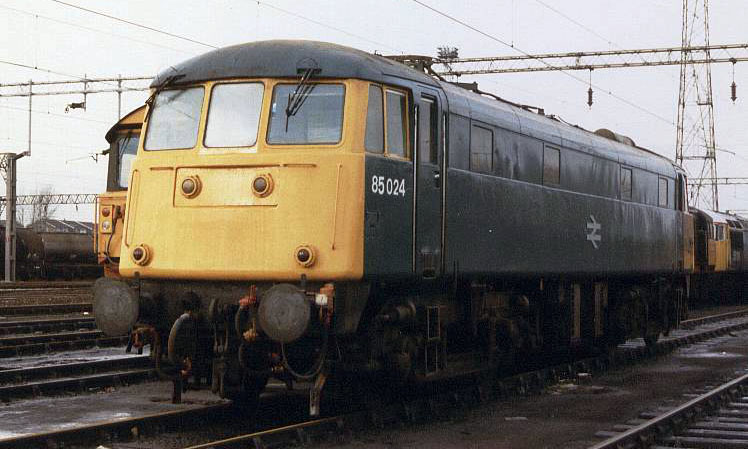- British Rail Class 85
Infobox Locomotive
name = British Railways AL5
British Rail Class 85
powertype = Electric
caption = 85024 at Bescot on14 February 1988 .
builder =British Railways ’Doncaster Works
builddate = 1961–1964
totalproduction = 40
gauge = RailGauge|ussg|lk=on|al=on
wheeldiameter = convert|4|ft|0|in|m|3|abbr=on
tractionmotors = convert|847|hp|abbr=onBTH 189, 4 off
transmission =
electricsystem =25 kV AC
whytetype =Bo-Bo
uicclass = Bo'Bo'
trainbrakes = Vacuum, Dual from 1968–1971
locobrakeforce = convert|69|LTf|kN|sigfig=3|abbr=on|lk=in
locobrakes = Air
length = convert|56|ft|6|in|m|2|abbr=on
width =
height =
weight = convert|79.5|LT|sigfig=3|lk=on
topspeed = convert|100|mph|abbr=on|lk=on
poweroutput = convert|3200|hp|abbr=on|lk=on
tractiveeffort = convert|50000|lbf|sigfig=3|abbr=on|lk=on
trainheating =Electric Train Heating
railroad =British Rail
roadnumber = E3056–E3095; later 85001–84040
axleloadclass =Route availability 6
retiredate = 1981–1992
disposition = One preserved, remainder scrappedThe
British Rail Class 85 is an electric locomotive built during the early 1960s, as part of BR's policy to develop a standard electric locomotive. Five prototype classes (81-85) were built and evaluated, which eventually led to the development of the Class 86 locomotive. The locomotives of Class 85 were Originally fitted withgermanium rectifiers which were eventually replaced bysilicon rectifiers. Forty of these locomotives were built from 1961-64 by BR at Doncaster Works. The class were used to haul trains on the then newly electrifiedWest Coast Main Line , fromBirmingham , toCrewe ,Manchester Piccadilly ,Liverpool and laterPreston . By 1965, electrification had spread south toLondon Euston .Under the earlier BR classification, the type was given the designation AL5 (meaning the 5th design of 25 kV AC Locomotive), and locomotives were numbered E3056-E3095. In 1968, this was changed to Class 85, when BR introduced a new computer numbering system. From 1971 onwards, locomotives were progressively renumbered into the 85001-040 series. Fifteen locomotives were converted for freight only use, numbered in the 85/1 series - see table below. These locomotives were restricted to 80mph.
Preservation
One locomotive has been preserved, 85101 (having previously numbered E3061 & 85 006) This locomotive is preserved by the
AC Locomotive Group , who also own examples of Classes 81-86. atBarrow Hill Engine Shed . It was named to commemorate the 150th anniversary of Doncaster Works, and is painted in "Railfreight Distribution " livery, a livery it never carried in service. Their intention is to eventually restore this locomotive to operational condition.Fleet Details
External links
* [http://www.aclocogroup.co.uk/ AC Locomotive Group - Owners of preserved locomotive no. 85101 / E3061]
Wikimedia Foundation. 2010.
